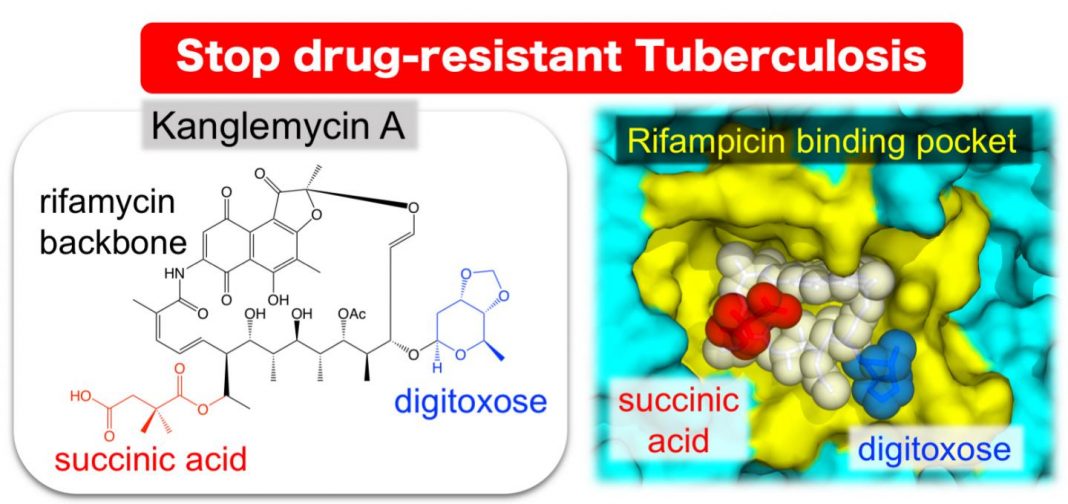Researchers report that a naturally occurring antibiotic, kanglemycin A, is effective against Mycobacterium tuberculosis, the bacteria that cause tuberculosis (TB), even in drug-resistant strains. The team, which used chemistry, molecular biology, microbiology, and x-ray crystallography to show how the compound maintains its activity, published its study (“Mode of Action of Kanglemycin A, an Ansamycin Natural Product that Is Active against Rifampicin-Resistant Mycobacterium tuberculosis”) in Molecular Cell.
“Antibiotic-resistant bacterial pathogens pose an urgent healthcare threat, prompting a demand for new medicines. We report the mode of action of the natural ansamycin antibiotic kanglemycin A (KglA). KglA binds bacterial RNA polymerase at the rifampicin-binding pocket but maintains potency against RNA polymerases containing rifampicin-resistant mutations. KglA has antibiotic activity against rifampicin-resistant gram-positive bacteria and multidrug-resistant Mycobacterium tuberculosis (MDR-M. tuberculosis). The x-ray crystal structures of KglA with the Escherichia coli RNA polymerase holoenzyme and Thermus thermophilus RNA polymerase-promoter complex reveal an altered—compared with rifampicin—conformation of KglA within the rifampicin-binding pocket,” write the investigators.
“Unique deoxysugar and succinate ansa bridge substituents make additional contacts with a separate, hydrophobic pocket of RNA polymerase and preclude the formation of initial dinucleotides, respectively. Previous ansa-chain modifications in the rifamycin series have proven unsuccessful. Thus, KglA represents a key starting point for the development of a new class of ansa-chain derivatized ansamycins to tackle rifampicin resistance.”
Kanglemycin A is related to the antibiotic rifampicin, according to Katsuhiko Murakami, Ph.D., professor of biochemistry and molecular biology at Penn State and one of the leaders of the project.
“Rifampicin is already part of the cocktail of antibiotics used to treat tuberculosis, but many strains of the tuberculosis-causing bacteria have developed resistance to it,” says Dr. Murakami, who added that TB is the leading cause of death by infectious disease worldwide. “Development of rifampicin resistance in M. tuberculosis has made treatment of this disease very difficult since it extends treatment time of tuberculosis from six months to two years. Identifying new compounds that are effective against the rifampicin-resistant bacteria is incredibly important for public health.”
The researchers screened a library of naturally occurring compounds from a U.K. biotech company, Demuris, for their ability to inhibit bacterial cell growth or prevent the production of RNA in bacteria. They discovered that kanglemycin A was effective at inhibiting RNA production even in rifampicin-resistant bacteria.
“Kanglemycin A is related to rifampicin, an antibiotic that functions by binding to bacterial RNA polymerase, the enzyme responsible for RNA production, and preventing it from making more RNA,” continues Dr. Murakami. “Understanding how kanglemycin A manages to maintain its affinity to rifampicin-resistant RNA polymerase and stay active against the drug-resistant bacteria will help to accelerate its approval for use in patients with tuberculosis.”
To determine the mechanism of kanglemycin A action against rifampicin-resistant RNA polymerase, Dr. Murakami's group used x-ray crystallography to determine the three-dimensional structure of the complex of kanglemycin A bound to bacterial RNA polymerase. It was known that rifampicin binds to a groove in the RNA polymerase molecule and that mutations that change the amino acid sequence of the RNA polymerase can prevent this binding, while maintaining the ability to produce RNA. Kanglemycin A binds to the same groove, but its structure revealed extensions that also bind just outside the groove allowing it to inhibit activity of rifampicin-resistant RNA polymerase.
“The x-ray structure actually revealed that kanglemycin A has two modifications that improve its function compared to rifampicin,” explains Dr. Murakami. “First, one of the modifications allows it to bind just outside of the rifampicin binding pocket increasing the strength of its affinity to the RNA polymerase in rifampicin-resistant bacteria. Second, another modification actually allows kanglemycin A to stop the synthesis of RNA even earlier than rifampicin.”
“It is a really exciting finding,” says Nikolay Zenkin, Ph.D., professor of molecular biology at Newcastle University and one of the leaders of the project. “The previously unknown interactions of the unique chemical groups of kanglemycin A with RNA polymerase will direct the development of antibiotics against rifampicin-resistant M. tuberculosis. Approximately one-third of the world's population is already infected with M. tuberculosis, and 600,000 people every year are diagnosed with rifampicin-resistant tuberculosis. Our work is the first step in developing a new drug for the treatment of these patients.”







